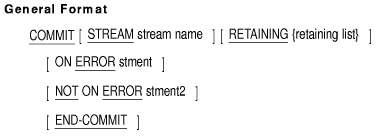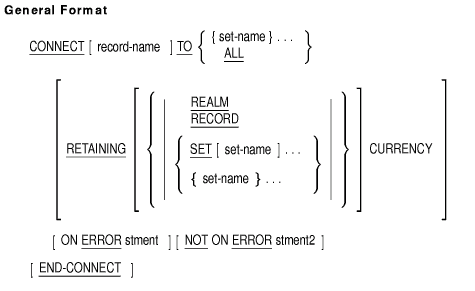 |
HP COBOL
DBMS Database Programming Manual
4.8.4 Translating DB-CONDITION Values to Exception Messages
Oracle CODASYL DBMS includes the following procedure for exception condition
handling:
Use this procedure when it is necessary to output an exception message
rather than, or in addition to, displaying the numeric value of
DB-CONDITION. For more information on the Oracle CODASYL DBMS database
special register DB-CONDITION, see Section 2.2.1, DB-CONDITION.
4.9 Database Programming Statements in the COBOL Procedure Division
The HP COBOL Oracle CODASYL DBMS DML statements are:
- COMMIT
- CONNECT
- DISCONNECT
- ERASE
- FETCH
- FIND
- FREE
- GET
- KEEP
- MODIFY
- READY
- RECONNECT
- ROLLBACK
- STORE
- USE (Format 3)
- The RETAINING clause
COMMIT
Function
The COMMIT statement ends your database transaction, makes permanent
all changes made to the database since the last quiet point, and
establishes a new quiet point for this run unit.

stment
is an imperative statement executed for an on error condition.
stment2
is an imperative statement executed for a not on error condition.
Syntax Rules
- The STREAM clause cannot be specified if the subschema entry (DB)
does not name a stream.
General Rules
- The COMMIT statement ends the database transaction.
- If you do not specify the STREAM clause, the COMMIT statement makes
all changes made to the database since the last quiet point for this
run unit; a new quiet point is established for the run unit.
- If you specify the STREAM clause, the COMMIT statement makes all
changes made to the database since the last quiet point permanent for
the specified stream; a new quiet point is then established for the
stream.
- If you do not use the RETAINING clause (see Section 4.9.1, RETAINING Clause), COMMIT:
- Empties all keeplists
- Resets all your currency indicators to null
- Releases all realm and record locks
- Makes visible any changes you made to the database
- Terminates the READY mode for each target realm
- If you do use the RETAINING clause, COMMIT:
- Does not empty keeplists
- Retains all currency indicators
- Does not release realm locks
- Demotes no-read record locks to read-only record locks, then
releases locks for all records except those in currency indicators or
keeplists
- Makes visible any changes you made to the database
- Maintains READY modes for each target realm
- If a database exception condition occurs during the execution of a
COMMIT statement, the DBCS places a database exception condition code
in the special register DB-CONDITION. This code identifies the
condition.
Additional References
- Section 2.2 on reserved words (database special registers)
- HP COBOL Reference Manual, Chapter 6, section on scope of statements
- Section 4.8.1, on database On Error condition
- USE statement (Format 3)
- Section 5.2.4, on subschema description (DB)
Example
COMMIT ON ERROR PERFORM 200-DISPLAY-ERROR-ON-COMMIT
END-COMMIT.
|
CONNECT
Function
The CONNECT statement inserts the current record of the run unit as a
member record into one or more sets. The set occurrence for each
insertion is determined by the currency indicator for the corresponding
set type.

record-name
names a subschema record type.
set-name
names a subschema set type.
stment
is an imperative statement executed for an on error condition.
stment2
is an imperative statement executed for a not on error condition.
Syntax Rules
- Record-name must reference a subschema record type.
- Set-name must reference a subschema set type.
- For each set-name in the TO set-name clause, the
record type of record-name must be a member record type of the
set type.
- The same set-name cannot be specified more than once in
the TO set-name clause.
- The same set-name cannot be specified more than once in
the RETAINING clause.
General Rules
- The current record of the run unit must be in a realm in ready
update mode and all records required by the Database Control System
(DBCS) to execute the CONNECT statement must be in a realm in available
mode. The CONNECT statement uses the current record of the run unit.
- Use record-name to check that the current record of the
run unit is a record type identical to the record-name record
type.
- The current record of the run unit must not already be a member of
set-name.
- For each set-name in the TO clause:
- The DBCS inserts the current record of the run unit into each
set-name as determined by the set currency indicator
associated with each set-name.
- The position where the DBCS inserts the record into the set is
determined according to the criteria for ordering the set defined in
the schema for set-name.
- When specifying the ALL option:
- The DBCS considers only those set types specified in your subschema
for which:
- The current record is not presently a member of any occurrence of
the set type.
- The record type of the current record is defined in the schema as a
member record type of the set type.
- For each such selected set type:
- The DBCS inserts the current record into the set determined by the
set currency indicator associated with the selected set type.
- The position where the DBCS inserts the current record into the set
is determined according to the set-ordering criteria in the schema for
the selected set type.
- Unless otherwise specified by the RETAINING clause (see
Section 4.9.1, RETAINING Clause), set type currency indicators for the connected sets
point to the connected record. All other currency indicators are not
affected.
- If a database exception condition occurs during the execution of a
CONNECT statement, the DBCS places a database exception condition code
in the special register DB-CONDITION (see Technical Notes). This code
identifies the condition.
- If the execution of a CONNECT statement results in a database
exception condition, no changes are made to the membership of the
current record in the database.
Technical Notes
CONNECT statement execution can result in these DB-CONDITION database
exception condition codes:
|
DBM$_CRUN_NULL
|
The currency indicator for the run unit is null.
|
|
DBM$_CRUN_POS
|
The currency indicator for the run unit specifies the position of a
vacated record in a record collection.
|
|
DBM$_WRONGRTYP
|
The record type of
record-name is not the same as the current record's type.
|
|
DBM$_NOT_MTYP
|
The current record is not a member record type of a set in the TO
set-name phrase.
|
|
DBM$_NOW_MBR
|
The current record is already a member of the set specified in the TO
set-name phrase.
|
|
DBM$_CSTYP_NULL
|
There is no current of set type for the set specified in the TO
set-name phrase. This occurs only if the set is not a singular
set.
|
|
DBM$_DUPNOTALL
|
The program attempts to connect a record to a set and its sort key
value is identical to another record's sort key value already in the
set.
|
|
DBM$_NOT_UPDATE
|
A realm is not in update usage mode.
|
|
DBM$_CHKMEMBER
|
The Oracle CODASYL DBMS CHECK (member) condition was evaluated to be false.
The database remains unchanged.
|
Additional References
- Section 2.2 on reserved words (database special registers)
- HP COBOL Reference Manual, Chapter 6, section on scope of statements
- Section 4.8.1, on database On Error condition
- Section 5.14.1, on RETAINING clause
- USE statement
Examples
- Connecting EMPLOYEE record to the CONSISTS_OF set:
CONNECT EMPLOYEE TO CONSISTS_OF.
|
- Connecting EMPLOYEE record to all sets:
- Connecting EMPLOYEE record to the CONSISTS_OF set without changing
the currency indicator of the CONSISTS_OF set:
CONNECT EMPLOYEE TO CONSISTS_OF
RETAINING SET CONSISTS_OF CURRENCY.
|
|

